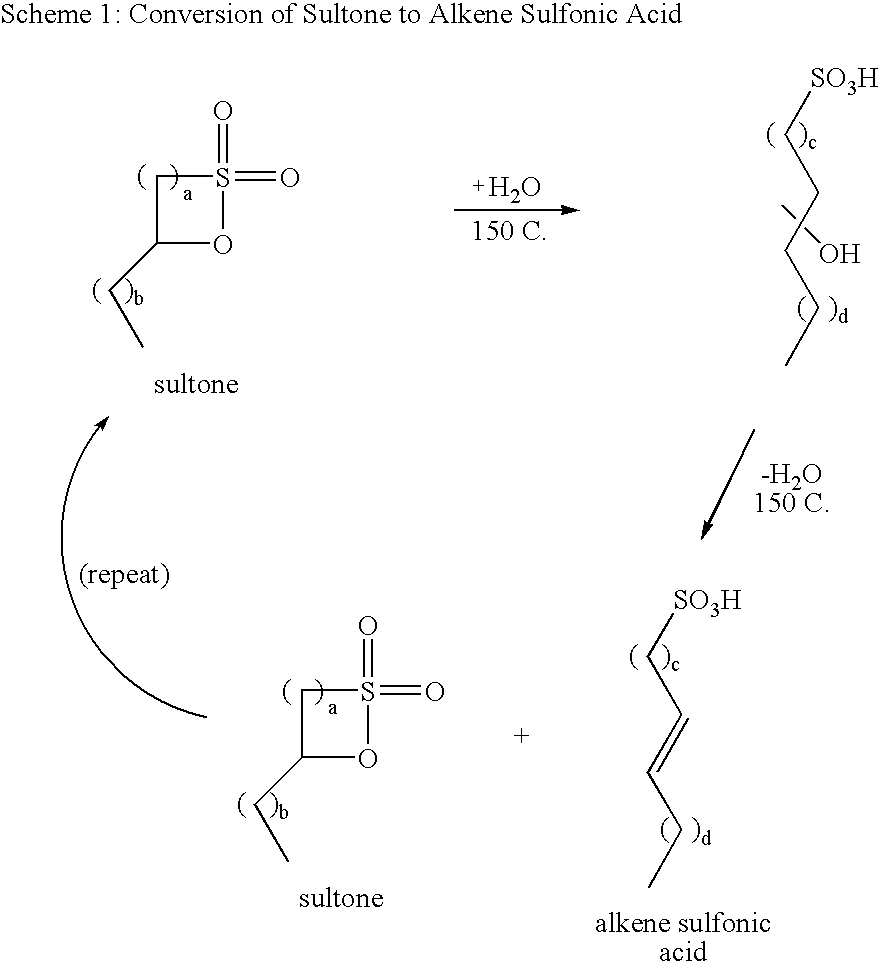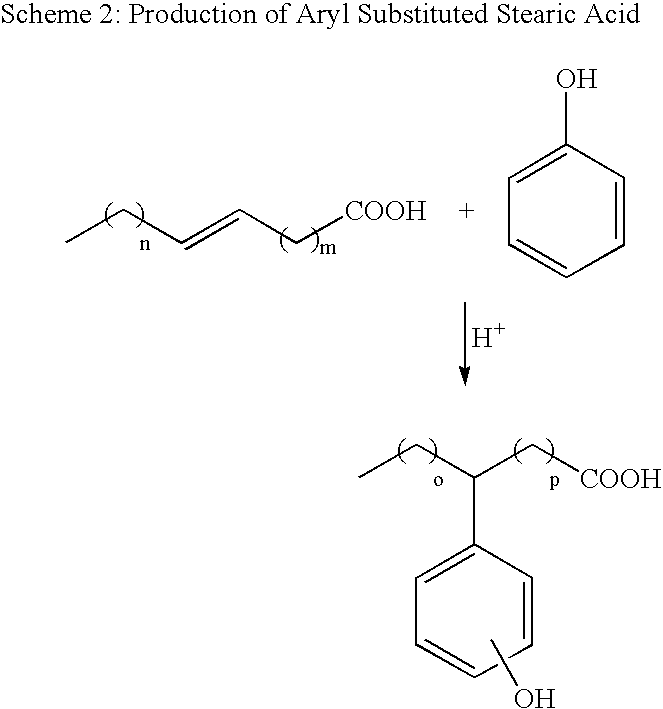Arylalkylsulfonic acids and methods for producing same
- Summary
- Abstract
- Description
- Claims
- Application Information
AI Technical Summary
Benefits of technology
Problems solved by technology
Method used
Image
Examples
example 1
[0098]This example demonstrates the utility of Nafion® NR50 perfluorosulfonic acid resin as a catalyst for the substantially anhydrous, high-yield preparation of C12 benzene alkylsulfonic acid from AOS acid. To a 300 mL glass-lined autoclave were added 20.0 g (0.0805 moles) of crude C12 alkene sulfonic acid (AOS Acid, EW=248.4), prepared via falling film reaction of 1-dodecene with SO3, 112 mL of benzene, and 20 g of Nafion® NR50 perfluorosulfonic acid resin catalyst that had been previously dried under N2 at 150° C. for 2 hours. As characterized by acid content and 1H NMR analysis, the starting crude AOS acid was a mixture of approximately 60% sultones and 40% alkene sulfonic acids. In order to remove incidental water taken up by the AOS acid during handling, the reactor was heated to 120° C. with a single valve of the autoclave open to atmosphere and 40 mL of benzene and benzene / water azeotrope were distilled off from the reaction mixture. At this point, the reaction mixture conta...
example 2
[0100]This example demonstrates the utility of a dispersion of Nafion® NR50 on silica (i.e., Nafion® SAC-13) as a catalyst for the high-yield preparation of C14-16 toluene alkylsulfonic acid from AOS acid.
[0101]For this reaction, C14-16 AOS acid (EW=286), prepared via falling film reaction of a 65:35 ratio of C14 / C16 alpha-olefins with SO3, was used. Acid titration and 1H NMR analysis indicated that this crude AOS acid was a mixture of approximately 60% sultones and 40% alkene sulfonic acids. To a 100 mL round bottom flask was added 11.0 g (0.0385 mole) of C14-16 AOS acid, 35.4 g (0.385 mole) of toluene, and several Teflon boiling chips. The flask was fitted with a short-path still and 20.5 mL (0.192 mole) of toluene and toluene / water azeotrope were distilled from the solution in order to remove trace amounts of water. The remaining solution consisted of a 1:5 molar ratio of AOS acid to toluene. Upon cooling, 26.1 g of the solution (10.0 g of AOS acid) was transferred to a 50 mL rou...
examples 3-6
[0115]These examples demonstrate the utility of superacidic materials as catalysts for the substantially anhydrous preparation of C12 benzene alkylsulfonic acid from C12 δ-sultone (1,4-sultone). Crude C12 AOS acid was digested at 90° C. for 24 hours to convert all alkene sulfonic acid and gamma sultone (1,3-sultone) to delta sultone (1,4-sultone). The acid was then dissolved in a 50 / 50 mixture of ethanol and water and neutralized to pH>10 with sodium hydroxide. This solution was extracted with several portions of hexanes, and the combined extracts were dried over MgSO4, filtered, and concentrated to a wax. The crude sultone was crystallized at −30° C. from hexanes (ca. 6:1 ratio hexanes to sultone), filtered while cold, and dried to afford high purity dodecene δ-sultone (dodecene-1,4-sultone) as a white, crystalline solid. The sultone contained less than 0.1% water, as determined by Karl Fischer titration.
[0116]For each reaction, 1 part dry catalyst, 1 part dodecene δ-sultone, and a...
PUM
| Property | Measurement | Unit |
|---|---|---|
| Temperature | aaaaa | aaaaa |
| Temperature | aaaaa | aaaaa |
| Temperature | aaaaa | aaaaa |
Abstract
Description
Claims
Application Information
 Login to View More
Login to View More - R&D Engineer
- R&D Manager
- IP Professional
- Industry Leading Data Capabilities
- Powerful AI technology
- Patent DNA Extraction
Browse by: Latest US Patents, China's latest patents, Technical Efficacy Thesaurus, Application Domain, Technology Topic, Popular Technical Reports.
© 2024 PatSnap. All rights reserved.Legal|Privacy policy|Modern Slavery Act Transparency Statement|Sitemap|About US| Contact US: help@patsnap.com










